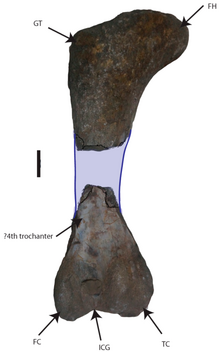Lapparentosaurus
| Lapparentosaurus | |
|---|---|

| |
| Partial left femur | |
| Scientific classification | |
| Domain: | Eukaryota |
| Kingdom: | Animalia |
| Phylum: | Chordata |
| Clade: | Dinosauria |
| Clade: | Saurischia |
| Clade: | †Sauropodomorpha |
| Clade: | †Sauropoda |
| Clade: | † Gravisauria
|
| Clade: | †Eusauropoda |
| Genus: | †Lapparentosaurus Bonaparte, 1986 |
| Species: | †L. madagascariensis
|
| Binomial name | |
| †Lapparentosaurus madagascariensis (Lydekker, 1895)
| |
| Synonyms | |
| |
Lapparentosaurus is a
Discovery and naming
In 1895
Classification
The phylogenetic position of Lapparentosaurus was long poorly understood. It exhibits an unusual combination of characters of both basal and derived sauropods.[7] It has been classified as a brachiosaurid or an indeterminate titanosauriform.[7] However, recent phylogenetic analyses have shown it to be a basal eusauropod, not closely related to brachiosaurids at all.[8] After many decades, Emilie Läng in 2008 recovered a traditional Cetiosauridae including Lapparentosaurus.[9] An in-depth revision in 2019 of the genus by Raveloson, Clark & Rasoamiaramana recovered a similar position with Lapparentosaurus being part of a paraphyletic Cetiosauridae, also including a multitude of similar Middle Jurassic cetiosaurids such as Chebsaurus, Ferganasaurus, and Cetiosaurus.[10] This position is supported by the presence of two autapomorphies common on both Lapparentosaurus and Cetiosaurus: a pyramid-shaped neural spine from the anterior dorsal vertebrae with tapering in shape or not flaring distally and loss of the spinodiapophyseal lamina on the dorsal vertebrae.[10]
Gallery
All possible remains of Lapparentosaurus:
-
Teeth
-
Teeth collected between 1934 and 1936
-
Cervical vertebra
-
Caudal vertebrae
-
Limb bones
-
Metatarsals
References
- ^ S2CID 128431891.
- ^ Bonaparte, J.F. (1986). "Les dinosaures (Carnosaures, Allosauridés, Sauropodes, Cétosauridés) du Jurassique Moyen de Cerro Cóndor (Chubut, Argentina)". Annales de Paléontologie (Vert.-Invert.). 72 (3): 325–386.
- .
- .
- ^ de, Ricqlès (1983). "Cyclical growth in the long bones of a sauropod dinosaur". Acta Palaeontologica Polonica. 28: 225–232.
- ^ Rimblot-Baly, F.; de Ricqlès, A.; Zylberberg, L. (1995). "Analyse paléohistologique d'une série de croissance partielle chez Lapparentosaurus madagascariensis (Jurassique Moyen): essai sur la dynamique de croissance d'un dinosaure sauropode". Annales de Paléontologie. 81: 49–86.
- ^ ISBN 0520254082.
- PMID 29085006.
- ^ Läng, E. (2008). Les Cétiosaures (Dinosaura, sauropoda) et les sauropodes du Jurassique moyen: revision systématique, nouvelles découvertes et implications phylogénétiques (Doctoral dissertation, Paris, Muséum national d'histoire naturelle).
- ^ .





